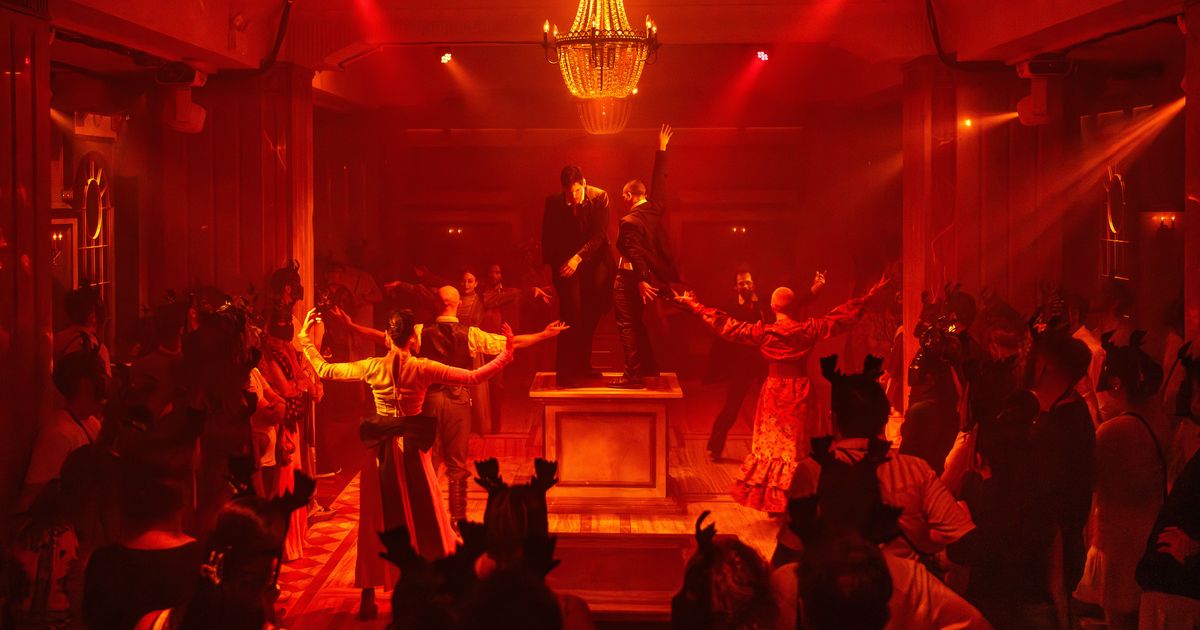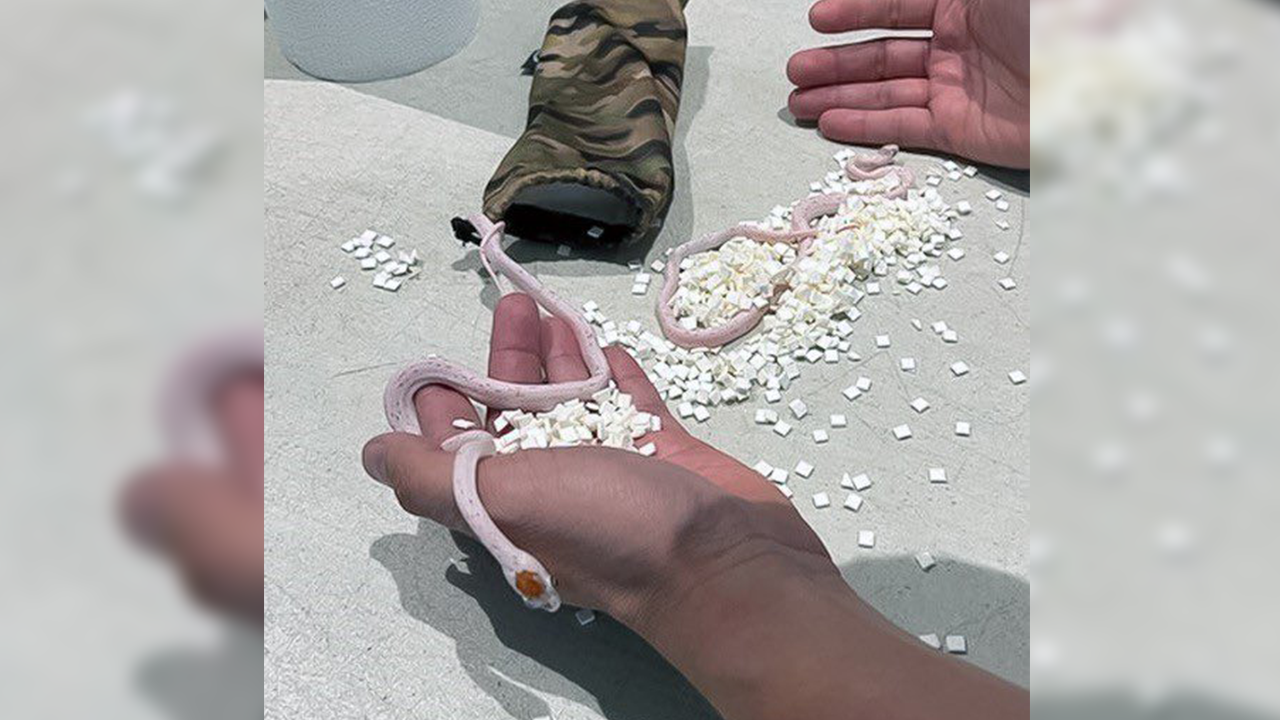From Life and Trust.
Photo: Jane Kratochvil
Somewhere either very far above or below the street level of the Financial District — it’s hard to tell when you’ve spent a few hours stumbling around in the dark — I ended up in the American West. In one of many hidden rooms inside the labyrinth of Life and Trust, the floor turned into the soft earth of a corral, the walls were painted with a view of red-rock mesas, and a performer in a cowboy getup was circling another man who happened to be wearing a horse mask. The horse was forced to the ground, then the other man stood above as the horse slowly rose up on his knees, seemingly tamed.
Watching the scene felt not unlike unlocking an achievement in a video game: I had been wandering up and down and across the six floors that compose this vast new immersive-theater project, hoping to find something cool to brag about discovering, and here it was. The choreography, by Jeff and Rick Kuperman (of muddy rumble in The Outsiders), was moody and muscular, and the action was mysterious enough without slipping into anything too coy and winking. I had the feeling of relief — Okay, thank God I found something that really stood out — both as an audience member and as a critic. Then, as the situation ended, the feeling of anxiety returned. The actors sped off to their next cues, and I scurried after them, hoping I had chosen a path that would return me to a compelling moment.
Those feelings, and indeed the general structure of Life and Trust, may be familiar to you if you happened to have strapped on a mask at Sleep No More over the past decade-plus of its run. Both are from the production company Emursive; Punchdrunk, the British group that also worked on Sleep No More, is not involved this time. (As Life and Trust opens, that Macbeth-via-Hitchcock experience, a big-enough 2010s sensation to inspire an episode of Gossip Girl, is about to close, though the date keeps getting deferred.) This early-20th-century fantasia is concocted by director Teddy Bergman (of the originally immersive KPOP) with the Kupermans as co-directors and a careful-what-you-wish-for book by Jon Ronson (of Okja; guess he likes anti-industrial fables).
As they arrive, audience members mill around the mysteriously large room housing the Art Deco Conwell Coffee Hall, a front that has been in operation for the past few months, before getting an invitation from an attendant to meet with the boss, J.G. Conwell. Once my small group of audience members assembled in Conwell’s office, we learned that he’d sold his soul to the Devil; letters in the Life and Trust logo are rather awkwardly emphasized to spell out Faust. In the show’s one introductory-dialogue scene — the rest of the show is pretty much all told through movement — the Devil comes for Conwell just before the 1929 stock-market crash. Before the debt is paid, Conwell begs for the chance to spend one night revisiting his life. The Devil, who I guess plays by A Christmas Carol rules, agrees, and Conwell is reborn into a younger actor’s sharp-jawed body. As in Sleep No More, the performers’s physiques are very much on display. The audience members are handed deerlike masks that unfortunately do make you think of pup play (if you wear glasses, I recommend contacts if you can wear them, as my frames kept slipping off) and are set loose to follow the young Conwell and a network of family members and contemporaries across a vast network of rooms.
The selling point of Life and Trust is its scale. My group entered into the action in a ballroom setting where members of Conwell’s family were miming a scene about an addiction to opiates. (A Sackler-ish turn of the plot involves Conwell making part of his fortune off the Devil’s recipe for a cure-all.) Then we splintered off in our separate ways into a warren of rooms. I followed one character after another down hallways and staircases through scenes that included a carnival, a boxing match, a bayou zone that made me specifically think of the pirate ride at Disneyland, a cave that may or may not have been hell, and performances at both a movie theater and vaudeville house.
To get the best understanding of the plot, it’s better to follow one character at a time: I spent a good amount of scenes with Conwell before deciding it might be more fun to track the devilish Mephisto, who kept getting up to no good in a corset. Once the characters all looped back to the ballroom about halfway through the three-hour experience, I felt more confident in just wandering. (I also wanted more space from the crowds clinging to the primary characters; though the AC is working hard, it’s hot in there on a summer evening.) The pride in stumbling onto something good comes hand in hand with a constant fear of missing out on something else. After attending, I recapped my experience with my co-workers, one of whom had wisely consulted Reddit threads from diehards who had created their own map of the experience, and they both told me they had found their way into a hidden room full of hundreds of tiny poodle toys. How could I have missed the poodle room?
Yet if the thrill of adventuring is there in Life and Trust, the vignettes themselves get repetitive quickly. Everyone from Evelyn Nesbit to Dorian Gray is liable to show up; it’s like Ragtime, if it were sexier and had more green liquid, or Nightmare Alley, specifically the remake. The scenarios tend to repeat the same patterns of seduction and corruption. Life and Trust lacks the throat-grabbing immediacy of Sleep No More’s concoction of horror and epic, sex and murder, and ends up with a more diffuse portrait of greed and betrayal. Americans, as it turns out, love to sell out, which is both true and unsurprising. I got tired of scenes in which people were negotiating or signing contracts; I could go see that anywhere in the Financial District. (“Why would the Devil be so into trapping a banker?” a friend asked afterward. “Wouldn’t he be pro-capitalism?”) The dynamic echoed commercial theater’s current love affair with missing-the-point adaptations of The Great Gatsby, a Faust story of its own with a bootlegger as the Devil.
Even if you offer a condemnation of the American Dream, what the Devil offers is the fun stuff: the surface-level Jazz Age aesthetics, the thrill of a good party. Avarice is hard to lampoon when you’re also selling themed drinks. Since Gatsby’s copyright has expired, I was surprised that Life and Trust didn’t take the opportunity to write those characters into a few scenes, too — though you might consider J.G. Conwell’s initials.
Life and Trust is at Conwell Tower at 69 Beaver Street.












